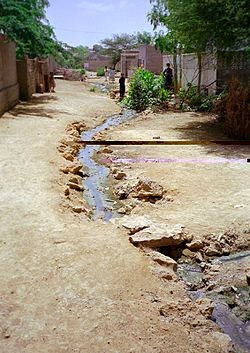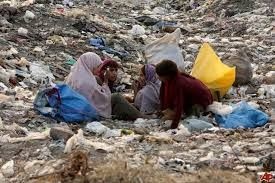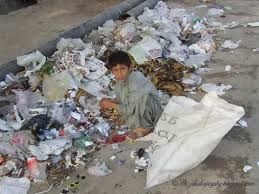Poverty in Pakistan
Poverty in Pakistan has fallen dramatically, independent bodies supported estimates of a considerable fall in the statistic by the 2007-08 fiscal year, when it was estimated that 17.2% of the total population lived below the poverty line.[1] The declining trend in poverty as seen in the country during the 1970s and 1980s was reversed in the 1990s by poor federal policies and rampant corruption.[2] This phenomenon has been referred to as the "poverty bomb".[3] In 2001, the government was assisted by the International Monetary Fund (IMF) in preparing the Interim Poverty Reduction Strategy Paper that suggests guidelines to reduce poverty in the country.[4]
Pakistan fares better than India and Bangladesh on most poverty markers such as the UN MPI index and its poverty rate is below those nations.[5]
As of 2009, Pakistan's Human Development Index (HDI) is 0.572, higher than that of nearby Bangladesh's 0.543, which was formerly a part of the country itself. Pakistan's HDI still stands lower than that of neighbouring India's at 0.612.[6]
According to the HDI, 60.3% of Pakistan's population lives on under $2 a day, compared to 79% in nearby India and 81.3% in nearby Bangladesh,the lowest rate in South Asia after Sri Lanka[7] and some 28.6% live under $1 a day, compared to 24.9% in India and 49.6% in Bangladesh[8]
Wealth distribution in Pakistan is highly uneven, with the top 10% of the population earning 27.6% and the bottom 10% earning only 4.1% of the income[9] According to the United Nations Human Development Report, Pakistan's human development indicators, especially those for women, fall significantly below those of countries with comparable levels of per-capita income. Pakistan also has a higher infant mortality rate (88 per 1000) than the South Asian average (83 per 1000).
Spatial distribution of poverty
At the time of the independence of Pakistan in 1947, Pakistan inherited the most backward parts of South Asia with only one university, one Textile Mill and one Jute Factory. The country has made tremendous progress and its per Capita GNP remains the highest in South Asia. During the last decade poverty elimination programs helped many of the poor to participate and rise up. However the Global financial crisis and other factors like the occupation of Afghanistan have impacted Pakistani growth. Poverty in Pakistan has historically been higher in rural areas and lower in the cities. Out of the total 40 million living below the poverty line, 30 million live in rural areas. Poverty rose sharply in the rural areas in the 1990s [11] and the gap in income between urban and rural areas of the country became more significant. This trend has been attributed to a disproportionate 
The Khyber Pakhtunkhwa of Pakistan was one of the most backward regions of the South Asia. Despite this, tremendous progress has been made in many areas. The NWFP now boasts several universities including the Ghulam Ishaq Khan University of Science and Technology.Peshawar a sleep cantonment during British towns is a modern cosmopolitan city. Much more can be done to invest in the social and economic structures. NWFP remains steeped in tribal culture, though the biggest Pahan city is Soviet invasion of neighboring Afghanistan is intact and according to Western reports supported the Taliban regime.[citation needed] These and other activities have led to a breakdown of law and order in many parts of the region.
Poverty and gender
The gender discriminatory practices in Pakistani society also shape the distribution of poverty in the country. Traditional gender roles in Pakistan define the woman's place as in the home and not in the workplace, and define the man as the breadwinner. Consequently, the society invests far less in women than men.[13] Women in Pakistan suffer from poverty of opportunities throughout their lives. Female literacy in Pakistan is 43.6% compared to Male literacy at 68.2%, as of 2008.[14] In legislative bodies, women constituted less than 3% of the legislature elected on general seats before 2002. The 1973 Constitution allowed reserved seats for women in both houses of parliament for a period of 20 years, thus ensuring that women would be represented in parliament regardless of whether or not they are elected on general seats. This provision lapsed in 1993, so parliaments elected subsequently did not have reserved seats for women. Reserved seats for women have been restored after the election of 2002 .[15] Female labour rates in Pakistan are exceptionally low.
Economic and social vulnerability
"Vulnerability" in this case stands for the underlying susceptibility of economically deprived people to fall into poverty as a result of exogenous random shocks. Vulnerable households are generally found to have low expenditure levels. Households are considered vulnerable if they do not have the means to smooth out their expenses in response to changes in income. In general, vulnerability is likely to be high in households clustered around the poverty line. Since coping strategies for vulnerable households depend primarily on their sources of income, exogenous shocks can increase reliance on non-agricultural wages. Such diversification has not occurred in many parts of Pakistan, leading to an increased dependence on credit.[17]
While economic vulnerability is a key factor in the rise of poverty in Pakistan, vulnerability also arises from social powerlessness, political disenfranchisement, and ill-functioning and distortionary institutions, and these also are important causes of the persistence of vulnerability among the poor.[18]
Other causes of vulnerability in Pakistan are the everyday harassment by corrupt government officials, as well as their underperformance, exclusion and denial of basic rights to many in Pakistan. Also, lack of adequate health care by the state lead

Lack of adequate governance
By the end of the 1990s, the manner in which power is exercised in the management of a country's social and economic resources for development emerged as Pakistan's foremost developmental problem. Corruption and political instabilities such as the insurgency in Balochistan and decade long armed conflict with the Taliban in Waziristan region resulted in reduction of business confidence, deterioration of economic growth, reduced public expenditure, poor delivery of public services, and undermining of the rule of law.[21] The perceived security threat on the border with India has dominated Pakistan's culture and has led to the domination of military in politics, excessive spending on defense at the expense of social sectors, and the erosion of law and order.
Pakistan has been run by military dictatorships for large periods of time, alternating with limited democracy.[22][23] These rapid changes in governments led to rapid policy changes and reversals and the reduction of transparency and accountability in government. The onset of military regimes have contributed to non-transparency in resource allocation.Those who do not constitute the political elite are unable to make political leaders and the Government responsive to their needs or accountable to promises. Development priorities are determined not by potential beneficiaries but by the bureaucracy and a political elite which may or may not be in touch with the needs of the citizens. Political instability and macroeconomic imbalances have been reflected in poor creditworthiness ratings, even compared to other countries of similar income levels, with resulting capital flight and lower foreign direct investment inflows. The current government of Pakistan has professed commitments to reforms in this area.[24]
In addition, Pakistan's major cities and urban centres are home to an estimated 1.2 million street children. This includes beggars and scavengers who are often very young. The law and order problem worsens their condition as boys and girls are fair game to others who would force them into stealing, scavenging and smuggling to survive. A large proportion consumes readily available solvents to starve off hunger, loneliness and fear. Children are vulnerable to contracting STDs such as HIV/AIDS, as well as other diseases.[25]
Poverty and Islamic militancy
Poverty and the lack of a modern curriculum have proved destabilizing factors for Pakistani society that have been exploited by militant organizations banned by the government to run schools and produce militant literature. Though many madrassas are benign, there are those that subscribe to the radicalist sect of Wahabi Islam,.[28][29]
As a result, militant Islamic political parties have become more powerful in Pakistan and have considerable sympathy among the poor. This phenomenon is more pronounced in the North Western Frontier Province.[30]
Inequality and natural disasters
The recent 2010 Pakistan floods have accentuated differences between the wealthy and poor in Pakistan. Abdullah Hussain Haroon, Pakistan's diplomat to the United Nations, has alleged that wealthy feudal warlords and landowners in Pakistan have been diverting funds and resources away from the poor and into their own private relief efforts.[31] Haroon also alluded to was evidence that landowners had allowed embankments to burst, leading to water flowing away from their land.[32] There are also allegations that local authorities colluded with the warlords to divert funds.[33] The floods have accentuated the sharp divisions in Pakistan between the wealthy and the poor. The wealthy, with better access to transportation and other facilities, have suffered far less than the poor of Pakistan.[34]



